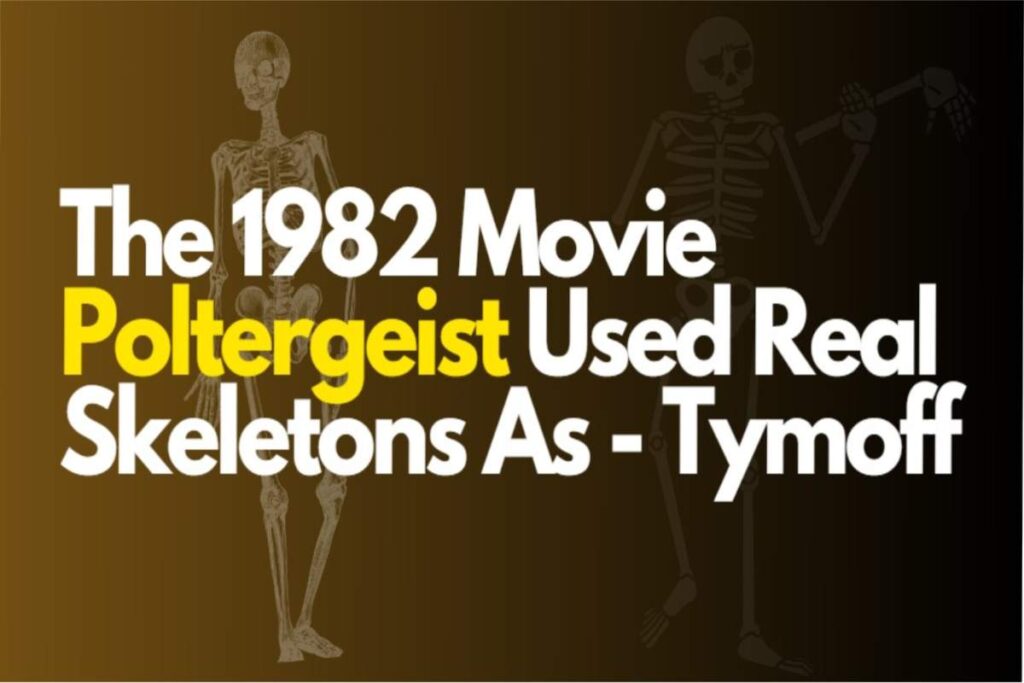Uncover the shocking truth about how the 1982 movie Poltergeist used real skeletons as – Tymoff. Dive into the behind-the-scenes secrets and controversies surrounding this iconic film.
The 1982 movie Poltergeist has cemented its place in cinematic history as a classic horror film. However, behind its chilling facade lies a controversial revelation: real skeletons were used during its production. In this article, we delve into the eerie details surrounding this aspect of the movie, shedding light on the practices of Hollywood’s past and the ethical implications they raise.
Revealing the Dark Secrets
The use of real skeletons in the filming of Poltergeist raises profound questions about the ethics of filmmaking.
The 1982 movie Poltergeist used real skeletons as – Tymoff, sparking a wave of controversy and speculation among audiences and industry insiders alike. While the practice of using real skeletons in films was not uncommon in the early days of Hollywood, it has since become a taboo subject due to ethical concerns and advancements in special effects technology.
The Controversy Unraveled
The decision to incorporate real skeletons into the production of Poltergeist was shrouded in secrecy and controversy.
The Origins of the Skeletons
The origins of the skeletons used in Poltergeist are murky, with conflicting accounts from various sources.
Speculations and Rumors
Speculations and rumors surrounding the source of the skeletons have fueled the controversy surrounding the film.
Ethical Considerations
The use of real skeletons in filmmaking raises important ethical questions that continue to resonate today.
Respect for the Deceased
One of the primary concerns surrounding the use of real skeletons is the lack of respect for the deceased individuals from whom they were obtained.
Industry Practices
The ethical implications of using real skeletons extend beyond Poltergeist, prompting a reevaluation of industry practices.
The Legacy of Poltergeist
Despite the controversy surrounding its production, Poltergeist remains a beloved classic among horror fans.
Cultural Impact
Poltergeist’s cultural impact is undeniable, influencing countless horror films that followed in its wake.
Enduring Mysteries
The mysteries surrounding Poltergeist, including its use of real skeletons, continue to captivate audiences to this day.
FAQs (Frequently Asked Questions)
What motivated the filmmakers to use real skeletons in Poltergeist?
The exact motivations behind the decision to use real skeletons remain unclear, with some speculating cost-cutting measures or a desire for authenticity.
Were the use of real skeletons in Poltergeist legal?
At the time of the film’s production, there were fewer regulations governing the use of real skeletons in filmmaking, leading to ethical ambiguities.
Did the use of real skeletons in Poltergeist impact its reception?
While the controversy surrounding the use of real skeletons may have generated publicity for the film, its impact on its overall reception is difficult to ascertain definitively.
What measures have been taken to prevent similar controversies in modern filmmaking?
In response to ethical concerns, modern filmmaking practices prioritize the use of synthetic materials and digital effects to replicate realistic imagery without resorting to real skeletons.
Has the use of real skeletons in Poltergeist influenced subsequent filmmaking practices?
The controversy surrounding Poltergeist has served as a cautionary tale for filmmakers, prompting greater scrutiny and accountability in the use of props and effects.
What lessons can be learned from the controversy surrounding Poltergeist?
The controversy surrounding Poltergeist serves as a reminder of the importance of ethical considerations in filmmaking and the enduring impact of decisions made during production.
The 1982 Movie Poltergeist Used Real Skeletons as – Tymoff – Conclusion
The revelation that the 1982 movie Poltergeist used real skeletons as – Tymoff continues to intrigue and unsettle audiences, underscoring the complexities of ethical decision-making in the film industry. As viewers revisit this iconic film, they are confronted with questions that transcend the realm of horror, prompting reflection on the intersection of art, ethics, and mortality.
Read Also : Tallyman Axis: Navigating Financial Stability Amidst Market Flux







